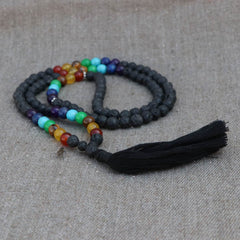$ 29.95
Unavailable
Description
History of praying flags
The tradition of hanging prayer flags is ancient, dating back thousands of years to India and then to Tibet and Buddhism. They were first used as banners to differentiate warriors going into battle. As Buddhism proliferated in Tibet during the seventh century and flags were used for blessings to protect Buddha, they became known as prayer flags. In accordance with Buddhist mythology, Gautama Buddha, whose teachings form the basis of Buddhism, was the first person to ever fly a prayer flag. Buddhist devas, who are not human but have godlike qualities, would take flags bearing Gautama Buddha's prayers into battle against asuras (devil). The vibrant colors of these flags aren't there for no reason. The flags are always displayed in the same order, from left to right: blue, white, red, green, and yellow, with each color representing a different element. The colors blue and white represent the heavens, red represents fire, green represents water, and yellow represents the earth. Collectively, the five hues represent equilibrium.
Material use in praying flags
Typically, 10 flags are strung together to form a "prayer flag," which is a rectangular piece of cotton that has been block printed with Buddhist symbols. They always consist of the same five colors and are arranged in the same order. The five colors, I learned after doing some research, stand for the five elements. They should be hung in the same order each time, from left to right.
Use of praying flag
The traditional purpose of prayer flags is to spread messages of love, compassion, power, and enlightenment. The Tibetans believe the prayers and mantras will be blown by the wind to spread goodwill and compassion into all-pervading space, contrary to popular belief that the flags carry prayers to gods. Mantras and prayers are also written on these and tossed into the wind. Nowadays, they are also used as decorative materials in different religious places and residential areas.
How to use praying flag?
According to tradition, if you hang them on the wrong dates you will receive obstacles instead of success. It's crucial to have positive intent when hoisting prayer flags. One should not have selfish or limiting thoughts. As you raise your prayer flags, think of ways you can help others and share your hopes for their wellbeing with the world. In Tibetan culture, prayer flags hold a spiritual significance. The flags should be treated with reverence because they contain sacred writings and symbols. They are not trash and should not be thrown away. Traditionally, prayer flags were burned when they were no longer needed, with the intention that their prayers would rise up in the smoke and be received by the gods. To avoid damaging the prayer flags, keep them off the ground as they burn. You should have compassion for all sentient beings and think back on the good intentions with which the prayer flags were made and blessed as you burn them.
Color Colorful
Brand Huge Bazaar LLC
Material Polyester and cotton













